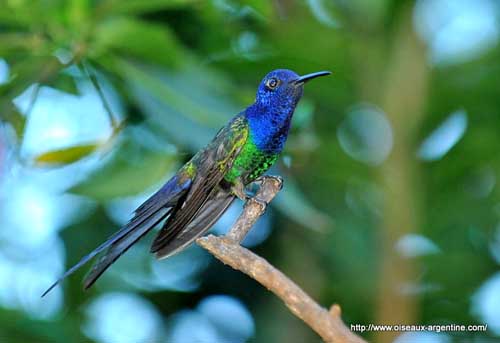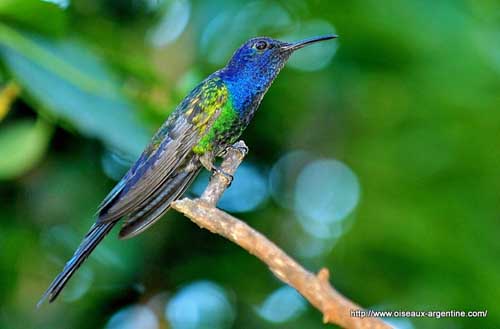
Fr: Colibri hirondelle
All : Blauer Gabelschwanzkolibri
Esp: Colibrí Golondrina
Ital : Colibrì codadirondine
Nd: Zwaluwstaartkolibrie
Sd: Svalstjärtskolibri
Port: Beija-flor-tesoura
Photographers:
Marc Chrétien
MURINUS
Jean Michel Fenerole
Photos d’Oiseaux du monde
Philippe and Aline Wolfer
OISEAUX D'ARGENTINE
Text by Nicole Bouglouan
Sources:
HANDBOOK OF THE BIRDS OF THE WORLD Vol 5 by Josep del Hoyo-Andrew Elliott-Jordi Sargatal - Lynx Edicions - ISBN: 8487334253
BirdLife International (BirdLife International)
About.com – Birding / Wild Birds
Wikipedia, the free encyclopaedia
Swallow-tailed Hummingbird
Eupetomena macroura
Apodiforme Order – Trochilidae Family
BIOMETRICS:
Length: 15-17 cm including bill: 2 cm, and tail: 7-9 cm
Weight: M: 8-9 g – F: 6-7 g
DESCRIPTION:
The Swallow-tailed Hummingbird is a beautiful bird, one of the largest of the family Trochilidae.
The adult male has blue-green to shiny bronzy-green upperparts and underparts, with iridescent plumage.
Wings are dark brown to blackish. The long tail is blue-green and deeply forked, giving the bird its name.
Head, throat and breast are blue or purple. We can see a white postocular spot.
The bill is black and slightly down-curved. The eyes are dark brown. Legs and feet are bluish-black, but the feathered thighs are white.

The female has similar plumage but duller, and she is slightly smaller than male.
The juvenile shows brownish tinge on head and neck.
We can find five subspecies:
E.m. macrourus, here described, is found in the Guianas, and N, C and SE Brazil to Paraguay.
E.m. simoni from NE Brazil has bluish-green back and underparts.
E.m. cyanoviridis from SE Brazil has shiny blue-green head, throat and breast, and golden bronzy-green back and underparts.
E.m. hirundo from E Peru has less deeply forked tail, and dull cobalt-blue head and throat.
E.m. bolivianus from NW Bolivia has greenish head contrasting with green back. Its plumage is clear and bright.
VOICE: SOUNDS BY XENO-CANTO
The Swallow-tailed Hummingbird gives fast, sharp “tik” as alarm call. Contact sounds are more elongated “seek” or “see-eeek”. We can also hear weak chattering.
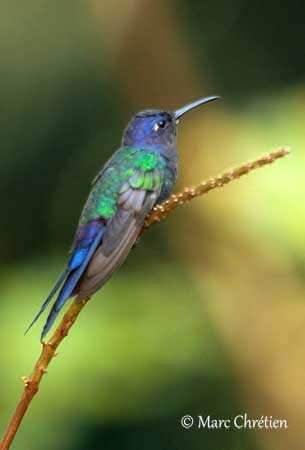
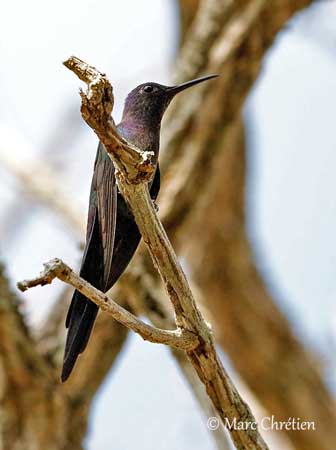
HABITAT:
The Swallow-tailed Hummingbird may frequent parks and gardens in urban and suburban areas if flowering trees are available. But it also frequents open areas with shrubs and trees, primary forest and edges.
This species is common from sea-level up to 1500 metres of elevation.
RANGE:
See above in “subspecies”.
BEHAVIOUR:
The Swallow-tailed Hummingbird feeds on nectar from numerous plant species, both native and introduced flowering trees. It also hawks insects in flight.
This large hummingbird is dominant at nectar sources, and can be aggressive against intruders. Both sexes dive bomb and chase even larger birds away from the feeding area, but also from the nesting territories. They often give warning calls during these actions.
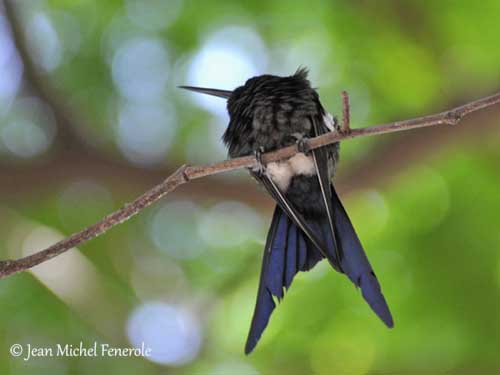
During the breeding season, the Swallow-tailed Hummingbird male performs some flight displays, making rapid zigzag flight dance with a mate. It also hovers in front of the perched female, and sings in leks for courting her during short period just before sunrise. There, each male has its own territory where it arrives just before dawn.
The Swallow-tailed Hummingbird may move over short distances N-S in Brazil in the dry winter months.
FLIGHT:
As other Trochilidae species, the Swallow-tailed Hummingbird hovers when feeding on nectar at flowering trees. It also performs graceful flight displays.
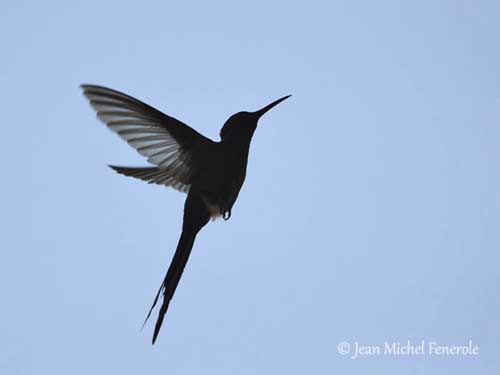
REPRODUCTION:
The breeding season occurs between October and March and until July in state of Sao Paulo.
The nest is placed between one and three metres above the ground on thin horizontal branch in tree or shrub. It may occasionally be built much higher, up to 10-15 metres in high tree.
The cup-shaped structure is made with lichen and mosses, held together with spider webs. The cup is lined with fine plant fibres.
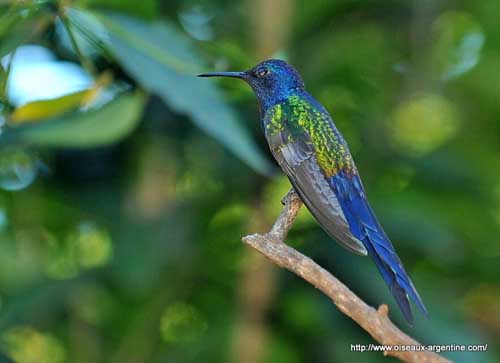
The female lays two white eggs, and incubates during 15-16 days. At hatching, the chicks are dark and covered with sparse dark grey down on back. They fledge 22-24 days later. They remain with the female during 2-3 weeks during which they return to the nest the first nights to sleep. They are sexually mature in the second year.
DIET:
The Swallow-tailed Hummingbird feeds on nectar from flowers and hawks insects in the air.
It defends strongly its feeding areas against intruders.
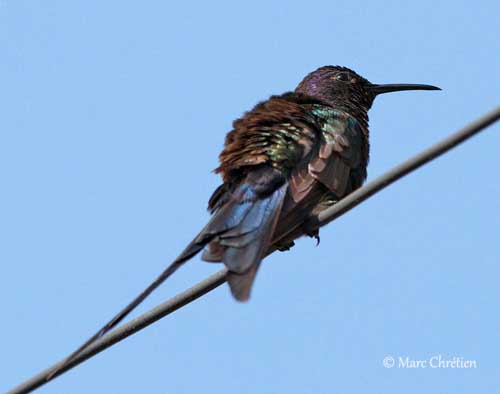
PROTECTION / THREATS / STATUS:
The Swallow-tailed Hummingbird is a common resident in Brazil and occupies man-made habitats in addition to the wild areas. This species has suffered heavy trapping for bird trade in the past, but these practices have ceased today.
The Swallow-tailed Hummingbird is not currently threatened.
